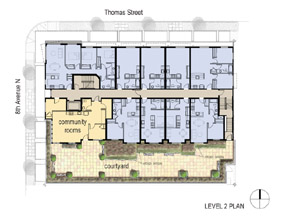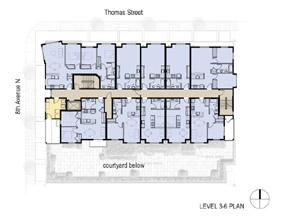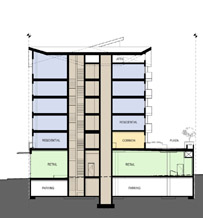 |
 |
| Project
Summary: Denny Park Apartments
OWNER/DEVELOPER
Low Income Housing Institute
ARCHITECT
Runberg Architecture Group
LANDSCAPE
ARCHITECT
SVR Design
CONTRACTOR
Rafn Construction Co. PROPERTY
MANAGEMENT
Low Income Housing Institute
| FUNDERS: |
TYPE: |
| Seattle Office of Housing |
Loan |
| Enterprise Community Partners, Inc. |
Grant |
| Bill & Melinda Gates Foundation |
Capital Grant & Services Grant |
| Washington State Housing Trust Fund |
Loan |
| Federal Home Loan Bank of Seattle |
Grant |
| Low Income Housing Tax Credits |
Tax Credit Equity |
| Seattle Housing Authority |
Capital Grant & Section 8 granty |
| Wells Fargo Bank |
Construction & Acquisition Loans |
| Washington Community Reinvestment Alliance |
Loan |
| Channel Foundation |
EQ2 Loan |
DEVELOPMENT
TYPE:
New construction rental apartments (mixed-use structure).
RESIDENT
PROFILE:
40% of units for households at or below 30% Area Median Income (AMI), 50% of units for household at or below 50% AMI, and 10% of units for households at or below 60% AMI.
DENSITY: 200 du/acre.
DEVELOPMENT
PROFILE
| Type |
#/Units |
Size
(sf) |
Rent |
| Studio |
26 |
424 |
$329-$544 |
| 1 BR |
11 |
548 |
$408-$876 |
| 2
BR |
8 |
702 |
$526-$876 |
| 3 BR |
5 |
1085 |
$607-$1012 |
| Total |
50 |
|
|
Community facilities: 2314 SF (common room, kitchen, laundry), 3000 SF landscaped courtyard
Parking: 35 stalls in structured parking
Total site area:
10,836 SF |
CONSTRUCTION
TYPE
5 storeys of wood frame (Type VA construction) over 1 storey + basement of concrete (Type I construction). Exterior materials include fibercement siding and metal siding, standing seam metal roof.
DEVELOPMENT
COSTS:
Land cost: $1,413,242.38; Constr. costs:
$7,629,136.72; Other costs: $1,782,659.91; Total
development costs: $10,825,039.01;
Completed in November 2005. |
|
|
Denny Park Apartments is a 55,000 square foot,
6 storey, mixed-use building in Seattle’s South Lake Union
neighborhood. The goal of Denny Park is to meet a growing need
for affordable housing downtown and promote economic
sustainability and livable neighborhoods. 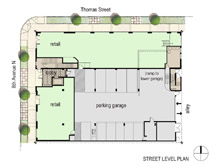
Fifty dwelling units
above street level commercial space serve households
at 30%, 50% and 60% of the median income, including eight transitional
housing units for homeless families with children. There is a
mix of studios, one, two and three bedroom units as well as a
common room with kitchenette adjacent to a courtyard.
An initial “green charrette” was
held with the entire design team, including the owner and the
general contractor, to identify sustainable design goals for
the project and how to achieve them efficiently. The team included
several LEED-accredited members, as well as representatives from
Seattle City Light, the Seattle Office of Housing, and an outside
consultant from the Lighting Design Lab. The project also went
through the city’s
design review process, which gave the public and neighborhood
organizations the opportunity to influence design. The main challenge
was to maximize residential density and minimize building area
given to parking. Pedestrian-friendliness was prioritized, with
glass canopies and sidewalk planters enhancing outdoor areas.
The planters also contain structural soil allowing groundwater
to recharge. Bicycle racks encourage bicycle use. Parking has
been minimized to encourage alternative transportation, made
feasible by proximity to transit. Located
on a quiet street that dead-ends at Denny Park, the site is well served by
several bus routes within 800 feet, each route providing service
at least 5 times per hour during peak hours. Only 30 residential
parking stalls and 5 commercial stalls are provided.
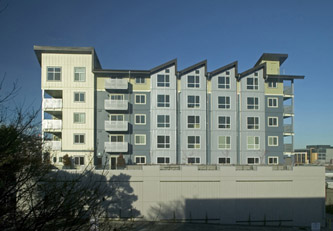 Denny Park Apartments sets an example for affordable and sustainably designed housing in a rapidly gentrifying neighborhood. The building uses interesting forms and colors to buck the stereotypical image of low-income housing. Avoiding mimicry, the design recalls the industrial history of the neighborhood while evoking a residential nature: a saw-tooth roof-form is reinterpreted as dormers; silver corrugated metal siding emphasizes bay windows. The ground floor responds to the urban fabric with zero-lot line development and commercial uses, while the massing of the upper residential floors sensitively avoids crowding the neighboring church by providing a courtyard as a buffer. Among other sustainable design features, the project showcases stormwater planters, the first to be built in Seattle for stormwater retention. These required close collaboration between the design team and Seattle Public Utilities and Department of Transportation. Denny Park Apartments sets an example for affordable and sustainably designed housing in a rapidly gentrifying neighborhood. The building uses interesting forms and colors to buck the stereotypical image of low-income housing. Avoiding mimicry, the design recalls the industrial history of the neighborhood while evoking a residential nature: a saw-tooth roof-form is reinterpreted as dormers; silver corrugated metal siding emphasizes bay windows. The ground floor responds to the urban fabric with zero-lot line development and commercial uses, while the massing of the upper residential floors sensitively avoids crowding the neighboring church by providing a courtyard as a buffer. Among other sustainable design features, the project showcases stormwater planters, the first to be built in Seattle for stormwater retention. These required close collaboration between the design team and Seattle Public Utilities and Department of Transportation.
The non-profit developer of the project
is committed to maintaining Denny Park Apartments
as affordable housing for the life of the building.
Therefore, durable materials were very important.
The project uses 50-year materials such as metal
siding, standing seam metal roofing, fibercement
siding and concrete. Durable precast concrete pavers
were used for the raised courtyard and smaller balconies
are made of durable recycled plastic/wood composite
decking. Siding was installed on a rainscreen system
over Typar building paper. Metal roofing was installed
above highly permeable polypropylene Roofshield,
a product that keeps moisture out while allowing
the roof to breathe, maximizing the
life of the wood frame structure. Indoor air quality
was a high priority as well when considering the
life of the building. Carpets are Carpet and Rug
Institute (CRI) Green Label indoor air quality certified,
paints are Master Painters Institute (MPI)
"Green-Performance” certified,
and sealants are all low-toxic and low-VOC. Countertops
are made from formaldehyde-free wheat fiber particleboard.
Continuously-operating whole house fans draw in fresh
air and smoking is not allowed in the building.
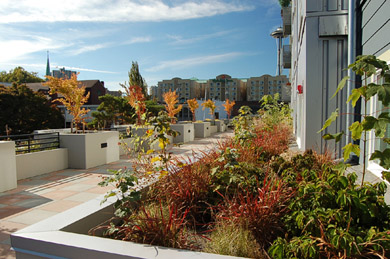 The
overall massing of Denny Park is oriented along an
east-west axis. Large windows maximize daylighting
in this cloudy climate, including in the corridor.
To avoid the effect of urban heat islands, metal
roofing that meets EnergyStar "cool
roof" criteria
was selected and sloped to direct rainwater to large
stormwater planters. A mix of drainage aggregate
and organic soil was engineered to achieve specific
percolation rates. The native plants selected
are suitable for stormwater retention yet are drought-tolerant.
Drip irrigation uses 32% less water than a conventional
spray system. Inside, NAHB-tested low-flow toilets.
EnergyStar dishwashers and front-loading clothes
washers promote water conservation. The
overall massing of Denny Park is oriented along an
east-west axis. Large windows maximize daylighting
in this cloudy climate, including in the corridor.
To avoid the effect of urban heat islands, metal
roofing that meets EnergyStar "cool
roof" criteria
was selected and sloped to direct rainwater to large
stormwater planters. A mix of drainage aggregate
and organic soil was engineered to achieve specific
percolation rates. The native plants selected
are suitable for stormwater retention yet are drought-tolerant.
Drip irrigation uses 32% less water than a conventional
spray system. Inside, NAHB-tested low-flow toilets.
EnergyStar dishwashers and front-loading clothes
washers promote water conservation.
Early in schematic design, an energy
life cycle cost analysis (LCCA) was done to determine
the most appropriate system for heat and domestic
hot water for the residential portion of this building.
The typical first cost-driven solution for multi-family
residential projects in the Northwest results in
electric resistance heat and individual electric
hot water tanks, which consume the most source energy
and have the shortest life span. Following the LCCA,
a central natural gas hydronic heat system and hot
water system were designed, which consume the least
amount of source energy while providing a longer
lifespan. Through the design development process,
further efficiencies were added: ultra-high efficient
95% Rheem-Rudd Advantage water heaters (95%) and
Munchkin condensing boilers with an AFUE of 93%.
In addition, light fixtures throughout Denny Park are EnergyStar fluorescent,
with occupancy sensors in common areas. The thermal
envelope was improved 17% beyond code requirements
with intermediate framing which differs from standard
framing in that corners are formed with 2 studs,
rather than 3 studs, avoiding uninsulated pockets.
In addition, all the wood headers are insulated
with R-10 rigid insulation. To minimize infiltration
the airtight drywall approach was used.
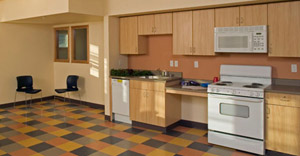 |
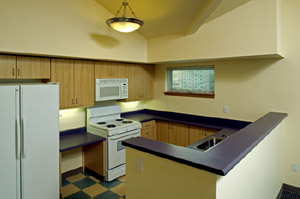 |
Products used containing recycled content were as follows:
drywall (12%), batt insulation (25%), concrete (18% fly ash), vinyl flooring
(23%), acoustic ceiling tile (ACT) (78%), light gauge steel (27%), and plastic/wood
decking (76-100%). Recycled glass cullet and recycled concrete were used for
fill below slab-on-grade and backfill. No chromated copper arsenate (CCA) was
used. ACQ (Alkaline Copper Quat) was used as a wood preservative instead, which
is arsenic-free and chromium-free. A construction jobsite recycling plan was
implemented with wood-only dumpsters, cardboard-only dumpsters, and commingled
dumpsters. Drywall scraps were recycled, as were materials from the demolition
of the previous building. Overall, 90.75% of construction waste was diverted
to recycling. To reduce waste, lumber and engineered wood were cut to length
by the mill before shipping, and walls were panelized.
Training sessions with maintenance staff emphasize sustainable design aspects. Upon move-in, each resident is given a welcome kit, with environmentally-friendly cleaning products and a description of the sustainable design features of their home.
Denny Park Apartments participated in the Seattle
Built Green program (3-star) and Built Smart, administered by the City of Seattle's electric utility, Seattle City Light. The project satisfies 159 different
items on the Seattle BuiltGreen Certification Checklist for sustainable
design. The project is also the City Office of Housing’s
ninth SeaGreen project, an initiative promoting healthy environments
while protecting and conserving resources. It was the first project
to receive funding under the Green Communities Initiative, a
five-year, $550 million commitment to build more than 8,500 environmentally
friendly affordable homes across the country sponsored by Enterprise Community Partners, Inc., the American Planning Association,
the Natural Resources Defense Council, the AIA and others.
Lessons Learned from the Architect
-
It was highly important to highlight the sustainability requirements in the Project Manual. The coordination of sustainability requirements got lost in the standard specification language, making it more challenging for subcontractors to decipher. A separate paragraph section and also separate requirements section would have clarified the requirements for the subcontractors and smoothed the process.
-
The central gas-fired ultra-efficient hot water system theoretically saves energy. However, we have yet to measure whether the anticipated energy savings have been realized. With a central system, the tenants do not see individual utility bills for their heat. Therefore, there may be a lack of a psychological incentive to conserve energy. The developer is in the process of gathering this information to see what energy savings have actually been achieved.
-
We value-engineered the hydronic heat system from a mechanical consultant-designed system to a design-build system with the performance criteria from the original system. This created extra work and placed a heavier burden on field review and decisions. If given the same option again, I would recommend against this choice.
Jury Comments
- Built smart-Built Green!
- Great detail of the metrics of the project
- Design seems a little cold and roof line seems overly complex.
AIA Green Housing Guidelines
|
Denny Park Apartments
|
1
|
Community Context |
Infill/ brownfield/adaptive re-use/high density |
Contaminated
soilsemoved and disposed of in accordance
with Department of Ecology requirements. Total of 35 cars for 50 units;
dwelling unit size average between studios, 1, 2 and 3 bedroom units
is 567 SF. 200
du/acre.
|
| Locate near public transportation |
Six
bus routes(17, 26, 28, 8, 5, 358) stop within 800 feet with bus
service at least 5 times per hour for each route during peak hours.
A future street car connecting the neighborhood to the downtown core
will have a stop 2 blocks from the project.
|
2 |
Site Design |
Pedestrian/bicycle friendly |
Continuous
glass canopies and sidewalk planters enhance the pedstrian realm. A
bicycle rack is provided in front of the building. Parking is minimized
to encourage use of alternative transportation.
|
3 |
Building Design |
Daylighting |
Building is oriented along east-west axis to minimize solar gain. Units are all either south-facing or north-facing. Windows are oversized (5' x 5' and 6' x 6') to maximize daylighting. Clerestory windows provided where possible. Corridor is naturally lit at the west end. |
| Green roofs/Cool Roofs |
Metal roofing that meets Energy Star "cool roof" criteria was selected. |
| High Performance Building Envelope |
Walls R-21; roof R-38; floors R-30. Intermediate framing improves building envelope 17% beyond code requirements. Airtight drywall approach. |
4
|
Water Conservation and Management |
Stormwater Management |
Stormwater
retention accomplished by stormwater planters located on a raised
courtyard above the parking garage and commercial spaces. A mix of
drainage aggregate and organic soil was specially engineered to achieve
specific percolation rates. Native plants suitable for
stormwater retention and are drought-tolerant. The plants and
planters permit the rainwater to be released back into the atmosphere
through evaporation and transpiration; surcharge is piped into
the city municipal storm drain in a controlled manner after being naturally
filtered. The soil in the sidewalk planting strips at the street level
was improved to a depth of 18” minimum with an engineered structural
soil to allow the groundwater to recharge more quickly. Drip irrigation
is provided to help establish the landscaping for the first two years
(using 32% less water than a conventional spray system).
|
| Water Saving Appliances |
NAHB-tested low-flow toilets. Energy Star dishwashers and front-loading clothes washers. Drip irrigation.
|
5
|
Energy Efficiency |
Energy Efficiency Heating and Cooling |
Metal roofing selected meets Energy Star criteria for a "cool roof." Building orientation based on basic principles of passive cooling. No air conditioning is provided. Continuously operating whole house fans draw fresh air. Central natural gas hydronic heat system including munchkin condensing boilers (93% AFUE) and hot water system including Rheem-Rudd Advantage water heaters (95% efficiency) were specified.
|
| Energy Star Appliances/Lighting |
Energy Star fluorescent light fixtures with occupancy sensors in common areas.
|
7 |
Recycling |
Recycled Content Materials or Recycling On Site |
Small balconies are of durable recycled plastic/wood composite decking (76% - 100%); outdoor benches of recycled plastic (100%), drywall (12%) batt insulation (25%); concrete (18% fly ash); vinyl flooring (23%); ACT (78%); light gauge steel (27%); metal siding (25%); fibercement siding uses recycled wood fibers; recycled glass cullet and recycled concrete used for fill.
|
8 |
IEQ |
Limit Emissions/moisture/sound/allergens |
Countertops made from formaldehyde-free wheat straw fiberboard; sealants are all low toxic and low VOC. Carpets are all CRI IAQ Green Label certified. Batt insulation is formaldehyde-free. Paints are all MPI "Green Performance" certified.
|
|
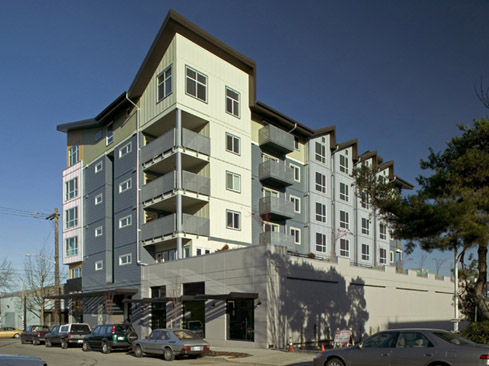

 Denny Park Apartments sets an example for affordable and sustainably designed housing in a rapidly gentrifying neighborhood. The building uses interesting forms and colors to buck the stereotypical image of low-income housing. Avoiding mimicry, the design recalls the industrial history of the neighborhood while evoking a residential nature: a saw-tooth roof-form is reinterpreted as dormers; silver corrugated metal siding emphasizes bay windows. The ground floor responds to the urban fabric with zero-lot line development and commercial uses, while the massing of the upper residential floors sensitively avoids crowding the neighboring church by providing a courtyard as a buffer. Among other sustainable design features, the project showcases stormwater planters, the first to be built in Seattle for stormwater retention. These required close collaboration between the design team and Seattle Public Utilities and Department of Transportation.
Denny Park Apartments sets an example for affordable and sustainably designed housing in a rapidly gentrifying neighborhood. The building uses interesting forms and colors to buck the stereotypical image of low-income housing. Avoiding mimicry, the design recalls the industrial history of the neighborhood while evoking a residential nature: a saw-tooth roof-form is reinterpreted as dormers; silver corrugated metal siding emphasizes bay windows. The ground floor responds to the urban fabric with zero-lot line development and commercial uses, while the massing of the upper residential floors sensitively avoids crowding the neighboring church by providing a courtyard as a buffer. Among other sustainable design features, the project showcases stormwater planters, the first to be built in Seattle for stormwater retention. These required close collaboration between the design team and Seattle Public Utilities and Department of Transportation.  The
overall massing of Denny Park is oriented along an
east-west axis. Large windows maximize daylighting
in this cloudy climate, including in the corridor.
To avoid the effect of urban heat islands, metal
roofing that meets EnergyStar "cool
roof" criteria
was selected and sloped to direct rainwater to large
stormwater planters. A mix of drainage aggregate
and organic soil was engineered to achieve specific
percolation rates. The native plants selected
are suitable for stormwater retention yet are drought-tolerant.
Drip irrigation uses 32% less water than a conventional
spray system. Inside, NAHB-tested low-flow toilets.
EnergyStar dishwashers and front-loading clothes
washers promote water conservation.
The
overall massing of Denny Park is oriented along an
east-west axis. Large windows maximize daylighting
in this cloudy climate, including in the corridor.
To avoid the effect of urban heat islands, metal
roofing that meets EnergyStar "cool
roof" criteria
was selected and sloped to direct rainwater to large
stormwater planters. A mix of drainage aggregate
and organic soil was engineered to achieve specific
percolation rates. The native plants selected
are suitable for stormwater retention yet are drought-tolerant.
Drip irrigation uses 32% less water than a conventional
spray system. Inside, NAHB-tested low-flow toilets.
EnergyStar dishwashers and front-loading clothes
washers promote water conservation. 

